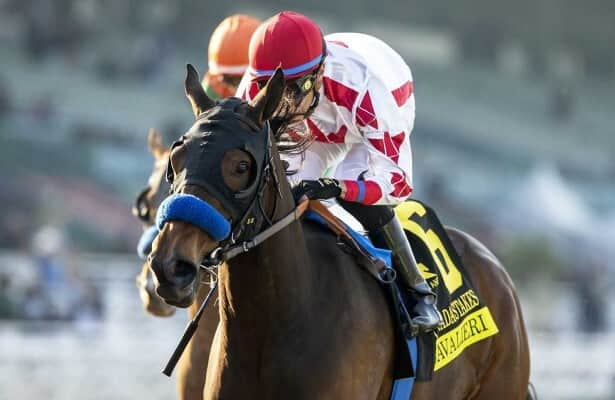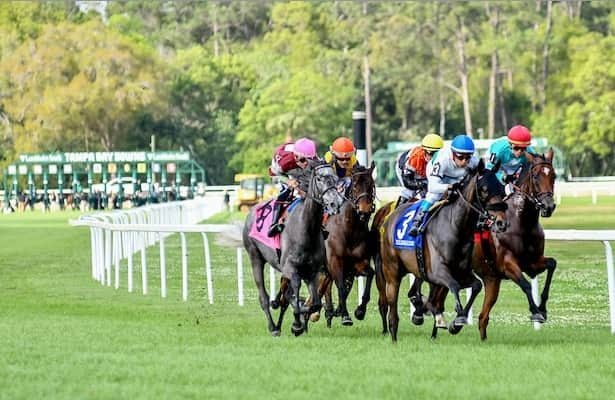Long before Jackie Robinson, Black jockeys dominated and changed horse racing

In the century before Jackie Robinson broke the color barrier in Major League Baseball and decades before Jack Johnson became the first African American heavyweight boxing champion, a Black man named Oliver Lewis won the first Kentucky Derby, in 1875, aboard a horse named Aristides.
That an African-American rider had the winning Derby mount just a decade after the Civil War would have come as little surprise to horse racing fans back then.
Thirteen of the 15 jockeys in that first Kentucky Derby were Black.
“The legacies of Black horsemen are as big as anyone,” said Brien Bouyea, director of communications for the National Museum of Racing and Hall of Fame in upstate Saratoga Springs. Among its inductees are two Black trainers and six Black jockeys — the first inducted in 1955, eight years after Robinson broke that color barrier, and the most-recent in 2024. “And, it’s a story that hasn’t been forgotten. It may have been pushed to the side for a long time, but now the authors are out there, the historians are out there, and they are trying to bring these stories out, the history of the sport, the foundation of the sport built by Black horsemen.”
It’s also a foundation weakened by time, European immigration and more opportunities in horse racing, far removed from the track, for people of color.
The Louisiana-born, New York-based Top 20 American jockey Kendrick Carmouche and other Black horsemen say honoring people of color who shaped racing history is something long overdue.
In 2025, the Jockeys Guild, which advocates for licensed thoroughbred riders in America, said just 8% of its more than 1,000 current members are Black. Statistics available from Equibase, a horse racing data provider, show just a handful of the Top 100 money-winning jockeys in the nation in 2024 were Black, including Carmouche, the highest-ranked at No. 17.
Jockey Kendrick Carmouche at the Aqueduct Racetrack in Jamaica, Queens, on Feb. 7. Credit: Jonathan Singh
Son follows jockey father
Like many, Carmouche, 41, got his foot in the door because he had connections. His father Sylvester, who died last August, was a well-known jockey in Louisiana. Among his mounts was Hallowed Dreams, a stakes winner who triumphed in her first 16 races in 1999-2001 to tie the record winning streak set by 2002 Hall of Fame inductee Cigar.
“I always wanted to be like my Dad,” Carmouche said last week between mounts at Aqueduct Racetrack in Queens, “because I saw when I was growing up white people never treated my Dad any different. That’s what I saw … I saw that I knew what I had to do, I knew how I had to go about it … I figured I can be anywhere in this world.”
“It bothers me a lot that [sports fans] think of Jackie Robinson and they don’t think of us,” said Ronald Tanner, 78, of Long Branch, New Jersey, who came out of the historic African American Hill District of Pittsburgh to become one of few people of color riding on the East Coast circuit during the 1960s Civil Right Movement. “That folks don’t really know a lot about the history of Black horsemen, of Black jockeys.”
Top left, Ronnie Tanner holds a picture from the first race he won in May 1966. Top right, a winner’s circle photo on the wall at his Long Branch, New Jersey, home. Credit: Ed Murray
Library of horse racing
Historian Roda Ferraro said there is much to learn.
Director of the Lexington, Kentucky-based Keeneland Library, considered the most-comprehensive library of horse racing in the nation, Ferraro used her expertise as an anthropologist researching the history of slavery and enslavement sites to help develop the library’s groundbreaking exhibit on African Americans’ contribution to the sport.
That exhibit, “The Heart of the Turf: Racing’s Black Pioneer,” has been viewed to date by more than 90,000 people from 32 countries. It will be on display at the National Museum and Racing Hall of Fame from July 10 to Sept. 28 to coincide with the summer race meet at Saratoga.
The exhibit includes entries on track life in the pre-Civil War and pre-Emancipation South, when nearly all non-ownership jobs in horse racing were held by men of color: jockeys, grooms, trainers, stable hands and hot walkers. It features more than 100 photographs, as well as artwork, interviews and archival material.
“The options you had as a Black man or woman were dictated — and, this goes without saying — on when you were born and where you were born,” Ferraro told Newsday. “And racing in the South then is built on the backs of enslaved boys and men, on servant horse farms, where that labor would’ve been more pronounced — boys as young as 4 or 5 put to work as stable boys, at 7 or 8 put on the back of a horse as an exercise rider and then 9 or 10 as jockeys … The younger they were the more likely they were to make weight.”
Horse racing as an option for 19th Century Black Americans meant, in effect, Carmouche said, “slaves could become un-slaves” — providing, experts said, financial benefits and opportunities rarely, if ever, otherwise available to anyone Black. Some of the best-known Black jockeys, trainers and groomsmen were able to acquire modest wealth, becoming landowners and business owners.
Credit: Newsday
Competition from immigrants
Those opportunities dwindled as immigrants from Europe, Ireland and the United Kingdom ramped up competition for jobs in post-Civil War America.
“Owners and trainers would get asked, ‘Why aren’t you using white riders?'” Bouyea said. “White riders would block Black riders on the track, would send them over the rail, to injuries and sometimes worse, and the stewards would do nothing about it.
“There was the whole Jim Crow era in America and with it, the era of the Black jockey in America was pretty much over by the turn of the century … Black riders who could went overseas.”
Since 1921, just four Black jockeys — Marlon St. Julien (2000), Patrick Husbands (2006), Kevin Krigger (2013) and Kendrick Carmouche (2021) — have even gotten mounts in the Kentucky Derby.
The last winning Black jockey in the Derby was 2004 Hall of Fame inductee James Winkfield, who won aboard His Eminence in 1901 and Alan-a-Dale in 1902.
Facing racial barriers in the U.S., Winkfield went to Europe in 1904, becoming Russia’s champion rider three times. When the Russian Revolution broke out in 1917, he even commandeered 200 horses and led them on a famed 1,000-mile ride out of Odesa.
Winkfield died outside of Paris in 1974. Each year, the New York Racing Association runs a race at Aqueduct in his honor.
While Black jockeys and horsemen no longer dominate thoroughbred racing, their contributions helped change the sport, according to Bouyea, Ferraro and other experts — change slow to come, but coming nevertheless.
Ronnie Tanner was a jockey in the civil rights era who displays winner circle photographs at his home in Long Branch, New Jersey, on Feb.10. Credit: Ed Murray
In 1971, Cheryl White, then 17, became the first Black female jockey — and, one of the earliest female jockeys of any color — in the United States, with a mount riding for her horse-owning father at Thistledown in Ohio.
In 2022, Black jockey Deshawn L. Parker, a two-time U.S. champion and longtime star at regional tracks like Mountaineer in West Virginia, became just the 21st jockey to ever win 6,000 races.
He’s still riding at age 54.
Racing becomes ‘melting pot’
Gone are the days when the biggest names in racing all are white.
“Racing has definitely become a melting pot,” Jockeys Guild New York regional director Keith O’Brien told Newsday: “It’s a smaller percentage of Black jockeys, yes. But the sport really is a reflection of society today.”
Birth countries of the Top 100 jockeys in 2024 included: France, Italy, Panama, Guatemala, Venezuela, Mexico, Peru, Chile, Brazil, Argentina, the Dominican Republic, Ireland, England, Japan and Canada.
The Lexington-based Ed Brown Society, named for the 19th Century Black trainer and 1984 Hall of Fame inductee, is working hard to take those transformational steps even further.
Led by Chairman Greg Harbut, a third-generation Black horseman whose great-grandfather was groom of legendary 1920 Preakness and Belmont Stakes winner Man o’ War, the society has partnered with the NYRA, Jockey Club, Churchill Downs and Keeneland racetracks, among industry leaders, to provide financial support, scholarships, internship placements and other life-changing opportunities for students of color.
The goal, the organization said, is to enable those “who demonstrate interest, skills and commitment to become trainers, farm managers, equine veterinarians, bloodstock agents and business professionals” — to open doors in all aspects of thoroughbred racing.
As Bouyea said: “You hear about integration in sports — and here is a sport whose entire basis was built on integration … Those contributions are being remembered more each day.”
Tanner, as a 16-year-old exercise rider in 1963, found the jockeys room bathroom at a Maryland track segregated by signage that, he said, read: “White Only, one side; Black Only, the other … I had never seen that before.” Tanner ignored the signs, went to the White Only bathroom, showered up. He later said he pulled down those signs — his contribution to the ongoing Civil Rights Movement.
Still, reminders remained, Tanner said.
He recalled how track officials failed even to take his photograph after he rode his first winner — on May 31, 1966, in Delaware, aboard an improbable 99-1 shot named Eastern Noon.
Six decades later?
“The same racism isn’t there anymore,” Tanner said. “If you’re a good jockey, you can get there.”
Carmouche agreed.
“White, Black, purple, it don’t matter,” he said. “I got kids … I want to show them no matter what color you are you going to be successful … Work for what you want, you’re going to get it out of life.”
Related
Leading Parx jockey Sanchez will serve 7-day suspension
Photo: Jason Moran / Eclipse Sportswire Jockey Mychel Sanchez will serve a seven-day suspension and pay an additional $1,750 in fines
Bill Mott talks about plans for Sovereignty, Just F Y…
Photo: Gulfstream Park / Lauren King Sovereignty, dramatic late-running winner of the Fountain of Youth (G2) March 1, is being pointed
Up-and-coming Cavalieri chases Grade 1 glory in Beholder Mile
Photo: Santa Anita / Benoit Photo Cavalieri and Alpha Bella, who finished one-two in the Grade 3 La Cañada in January at Santa Anita,
4 stakes showcase shipping stars on Tampa Bay undercard
Photo: Gonzalo Anteliz Jr. / Eclipse Sportswire The stars will shine Saturday at Tampa Bay Downs, and not just in the Grade 3 Tampa Ba












